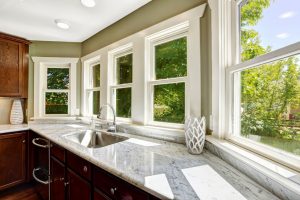
Natural lighting is one of the most important aspects of a living space. It influences both the physical properties of a room, as well as the physical and mental state of the people inside. Light should have adequate intensity, but also be distributed as homogeneously as possible. The most comfortable light, which ensures a good visual appearance of surfaces and volumes, is the diffused light. Direct sunlight has the property of animating a space, but it is important to control its amount, to prevent the effect of glare or overheating.
Besides the geographic location of the building, its orientation towards the cardinal points, the weather conditions, the season, the time of day, the obstacles facing the windows (vegetation, buildings, etc.), the most important factors in harnessing natural light are the size of the windows, their shape and position, and the degree of glass transparency.
The glass surface is important in relation to the surface of the room. To illuminate a large room, we will need larger windows. The optimal ratio windows / room surface for living quarters is between 1/6 and 1/10. For educational spaces this ratio is between 1/4 and 1/6, as for spaces requiring precision (laboratories, drawing rooms, etc.) it reaches up to 1/2 – 1/4. This ratio represents the lighting coefficient.
If we take the example of a living room of 20.00 square meters and we apply the ratio 1/8, it results a glass surface of 2.50 square meters (we are talking about clear glass surface, without window frames).
The shape and layout of the windows influence the depth of light penetration, as well as the distribution throughout the room. A higher window (in size or placement) will favor a better lighting of the deep areas of the room. A measurable parameter of the interior lighting is the depth coefficient. It represents the ratio between the length of the room (from the window to the opposite wall) and the height of the top edge of the window (measured from the floor). The value of this index should be less than 2.
The technical characteristics of the windows decisively influence the quantity and quality of natural light. There are plenty of glass types to control the properties of light. Even clear glass, used in the most common windows, has a certain light absorbing effect, involuntarily reducing the amount of light. This property is known as the absorption coefficient and measures the percentage of light absorption when it passes through the glass. It is one of the main reasons to hire one of the best window companies when upgrading your windows.
Recommendations:
- Position the windows by taking into account the interior functional areas, but also the exterior volume of the building
- Windows will be as high as possible, for the diffused light to reach the deep areas of the room
- In deep rooms, you should consider lighting options on both sides
- Avoid direct sunlight in important areas of the room
- Design the exterior landscaping, by taking into account the needs of interior lighting
- Direct light can be diffused in the room by a white wall adjacent to the window
- Install light colored floors that reflect the light from the South and North oriented windows
- Install dark-colored floors in rooms with West and East oriented windows, to reduce the blindness effect produced by the sun close to the horizon.
